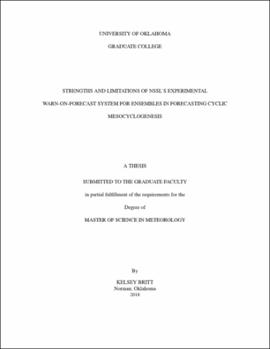| dc.description.abstract | Cyclic mesocyclogenesis is the process by which a supercell produces multiple
mesocyclones with similar life cycles. Supercells that exhibit cyclic mesocyclogenesis
(i.e. cyclic supercells) have the potential to produce several tornadoes that could cause
widespread damage. Therefore, having the ability to forecast the potential for cyclic supercells
may be beneficial for forecasters when issuing watches and warnings. However,
idealized simulation studies of cyclic mesocyclogenesis have found the process to be highly
sensitive to both environmental and computational parameters. Thus, whether or not shortterm,
storm-scale numerical weather prediction models can actually resolve and predict
cycling has yet to be determined. This study performs three sensitivity experiments using
forecasts generated by NSSL’s Experimental Warn-on-Forecast System for Ensembles
(NEWS-e) for four cyclic supercells occurring on 9 May, 16 May, and 18 May 2017.
NEWS-e, created as part of theWarn-on-Forecast (WoF) initiative, is a convection-allowing
ensemble with 18 forecast members. The sensitivity experiments included changing the
NEWS-e horizontal grid spacing from 3 km to 1 km, examining the effects of each forecast
member’s different PBL and radiation schemes, and analyzing how changes in the environment
across the different storms can affect the cycling process. Analysis of the individual
ensemble members is conducted to assess the capability of a NEWS-e to resolve and predict
cyclic mesocyclogenesis, and whether this process is physically representative of the current
understanding of cyclic supercells. To provide a source of verification for the NEWS-e
forecasts, a database of observations was created from manually analyzed WSR-88D radar
reflectivity and radial velocities for each supercell.
Based on past research, the coarsest grid resolution thought to resolve cycling was
1 km. However, seven 3-km, NEWS-e forecasts for 18 May 2017 show evidence of cyclic
mesocyclogenesis-like processes occurring in both cyclic supercells observed that day.
When the NEWS-e grid spacing was changed to 1 km, cycling was observed more frequently
than at 3 km, but there was little skill in NEWS-e predicting the timing of cycles compared to observations. Also, PBL and radiation parameterizations showed no clear impact
on cyclic mesocyclogenesis. Analysis of storm-relative helicity (SRH) 0–1 km fields
show differences between cycling and noncycling forecast members. Noncycling members
had higher SRH values than those members that exhibited cyclic mesocyclogenesis.
Given the limited dataset, NEWS-e shows promise in forecasting the probability that cyclic
supercells can occur on a given day. | en_US |
